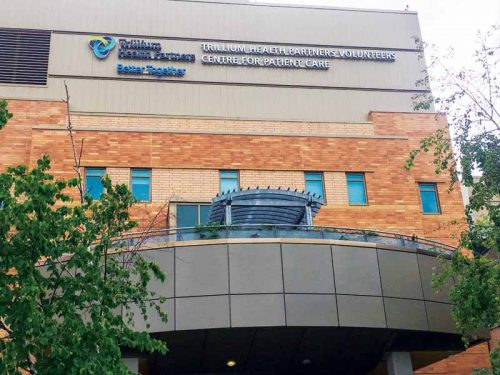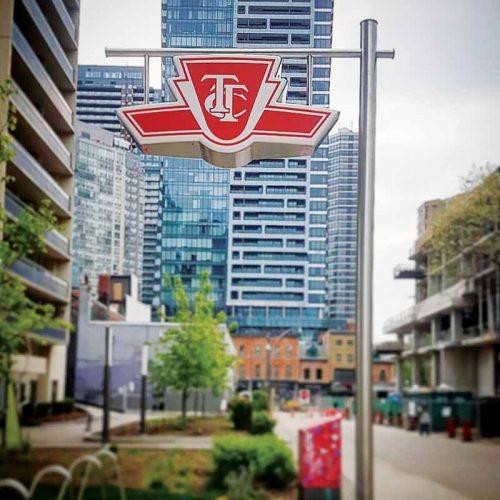
When it comes to branding, the design team at Gregory Signs is always on the lookout for new products and technology, and is constantly seeking new ways to implement their creative ideas in a way that singles out their client’s business from the rest.
SMC: What kind of projects have you been working on recently?
BK: We are heavily involved with the transportation industry such as the Toronto Transit Commission (TTC), Crosslinx Transit Solutions (CTS), Metrolinx, and GO Transit. We are currently manufacturing and installing signs for the TTC’s new development and renovation projects. Recently, we were commissioned for a $4-million contract for the Eglinton Crosstown expansion for 14 stations.
Our staff is also busy with supplying and installing interior and exterior signage for the Ontario Provincial Police (OPP) stations across the province. We are also working with Bird Construction on the new Niagara Entertainment Complex. This is an exciting project as we will be doing everything, right from design consulting to interior and exterior signage. Currently, we are also working on wayfinding signage for cemeteries. This type of work is new to us, but we are thoroughly enjoying it.
Among these, we have also been awarded a mall renovation project in Boca Raton, Fla., to remove existing signs and install temporary signs during construction, channel letters, and new pylon signs.
Gregory Signs also specializes in high-rise signage where we work closely with architects and design firms on sign programs and wayfinding packages before they go out to tender.
We have a huge client list including EllisDon, PCL, Buttcon Ltd., Maystar, Vestacon, Arguson Projects Inc., Forge, Icon, Envision, and Modulex, to name a few.
We service and install signs across Ontario, but have local installers take care of projects across the province. Many of our clients are located or have jobs around the globe. We have been shipping signs to the Dominican Republic, England, United States (Chicago, New York, Virginia, and Florida), and Canada (Alberta, British Columbia, and Manitoba).
Our shop also manufactures signs for TAG, Breitling, and Omega watches for a local company in Toronto that are shipped across North America.
SMC: What type of equipment do you currently use to complete your sign projects?
BK: At the moment, we have two computer numerical control (CNC) machines, HP printers, an Epson printer, a Vutek plotter, a laminator, two paint systems—AkzoNobel and Matthews Paint, and a spray booth. We also use a bending machine, a waterjet cutting machine, metal inert gas (MIG) and tungsten inert gas (TIG) welding equipment, break and drill presses, and shears. Our installation equipment comprises crane and bucket trucks, scissor lifts, and Genie lifts.

The Sign Shop is currently installing and manufacturing signs for Toronto Transit Commission’s (TTC’s) new and development and renovation programs.
SMC: What does your planning and design process involve?
BK: We like to invest time in design and planning; this is a critical stage in the sign development process and should not be rushed. Some projects can range from $250,000 to $1 million. We conduct site checks and content reviews before we start with the design layout. For example, we carefully check to ensure all the arrows are pointing in the right direction, the sign is located appropriately where it can be seen clearly, the wall where the sign is to be installed and the sign itself are not of contrasting colours, etc.
We take several preliminary measures before signs go into production. Most of the time, we are awarded signage projects when the building construction has just started. Therefore, it is important we try to nail down all this information as soon as possible, so we can start production and make sure the signs are ready for installation.
Our project managers are hands on and frequently visit sites to check on the job’s progress and to see if anything has changed. In many cases, things get altered during the construction process, especially when it comes to mechanical and electrical jobs. For example, a sign may have been designated a particular spot, but once the building is complete, a steel beam may be in the way because nobody informed us about the last-minute change, or a fire alarm was placed where a sign was to be installed. We need to be prepared for these changes, too.
SMC: What makes Gregory Signs different from other companies in the industry?
BK: Gregory Signs has a simple approach—we treat our customers the same way we would like to be treated. Irrespective of the size of the company or its project, we collaborate with both international and small local organizations.
We are continuously developing our systems and work practices to improve efficiencies and abilities so we can foster strong and lasting relationships with our customers. We believe in being honest about our products and services and strive to provide unparalleled customer service with every engagement.
Corporate social responsibility is also a top priority for us. We provide our products to various non-profit organizations and extend our services to worthy causes; after all, the small things we do as a company can have a large impact on others’ needs.
Last but not least, our employees are our asset. The growth of individual team members drives the success of our company. Employees are motivated to perform when their efforts are recognized, and they are rewarded for their skills and talent. We also see our suppliers and subcontractors as part of our team, and continue to develop a network of external associates to assist us in delivering what we promise.





